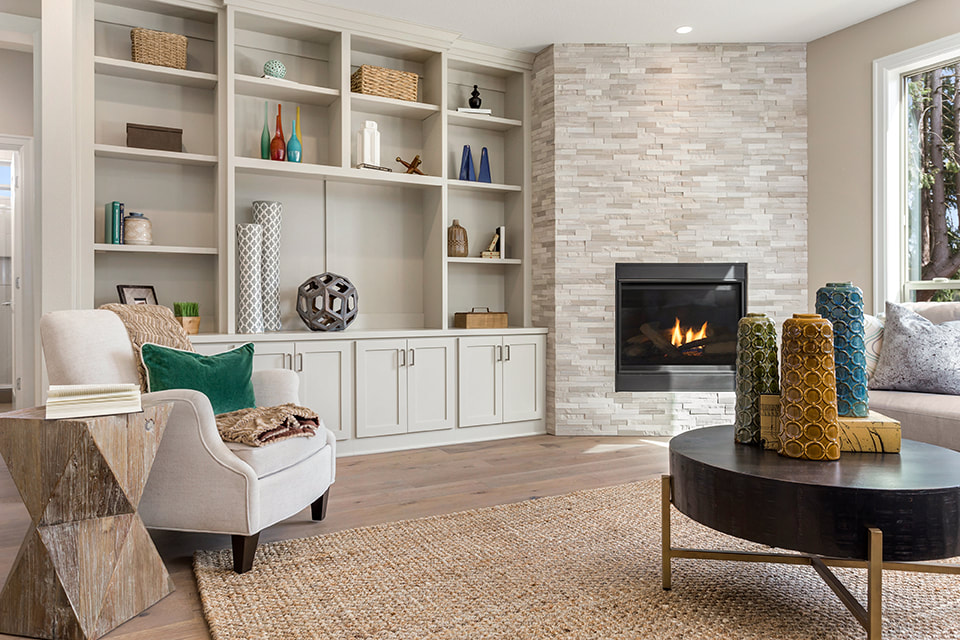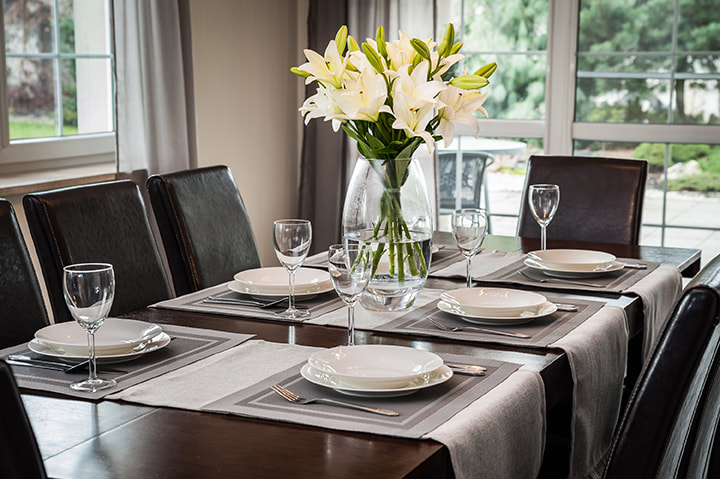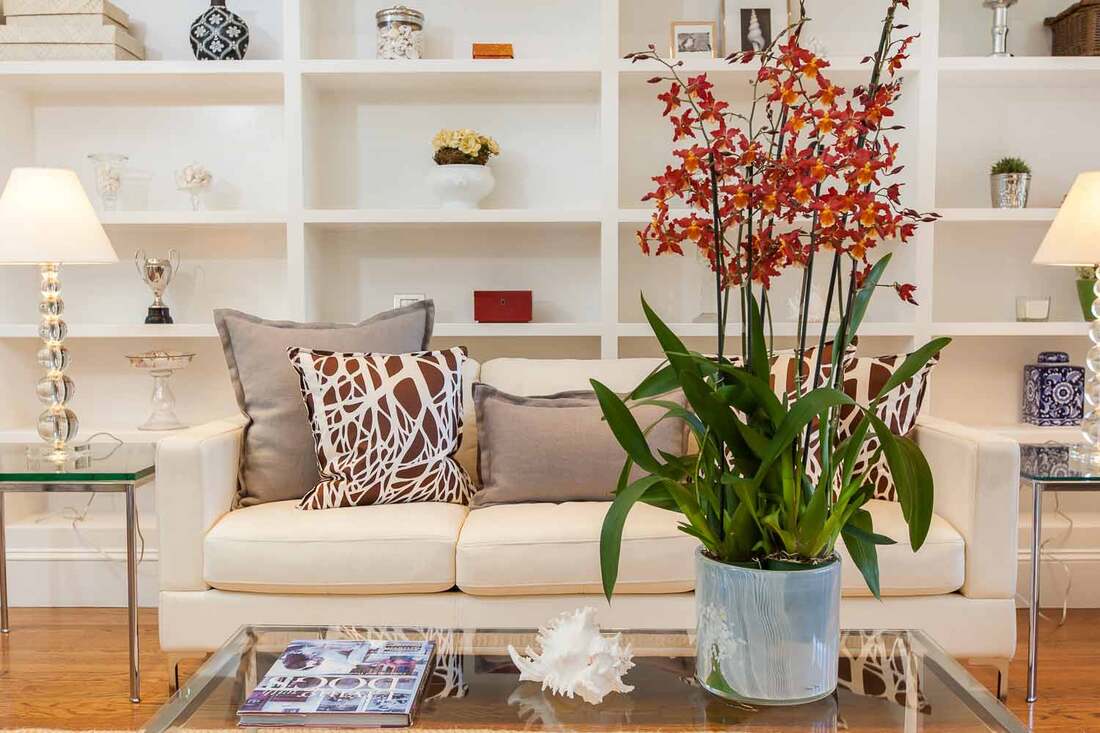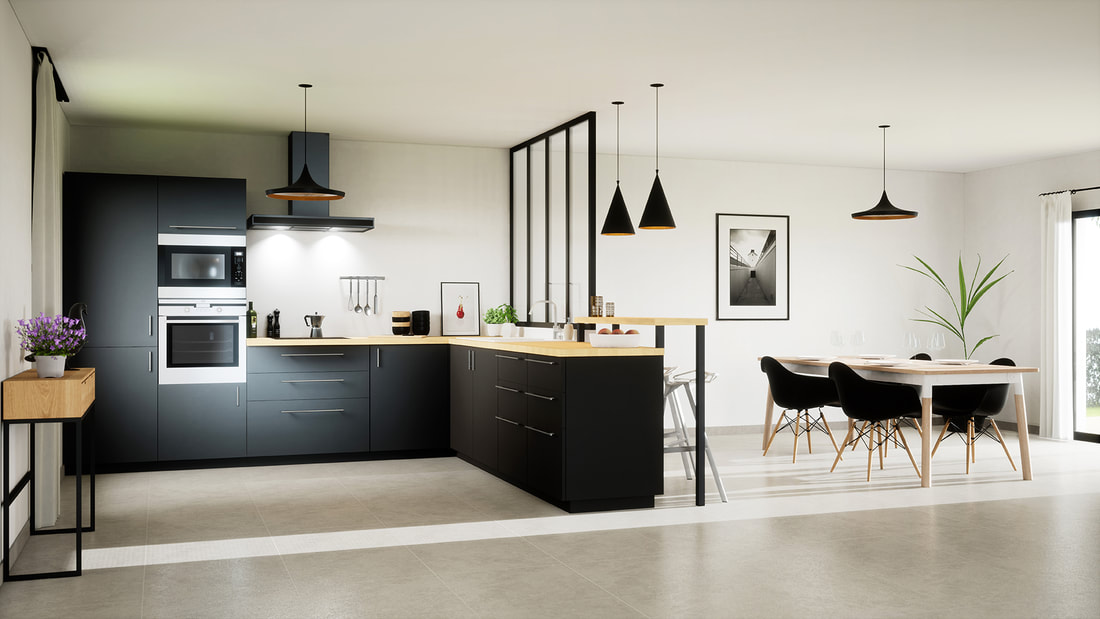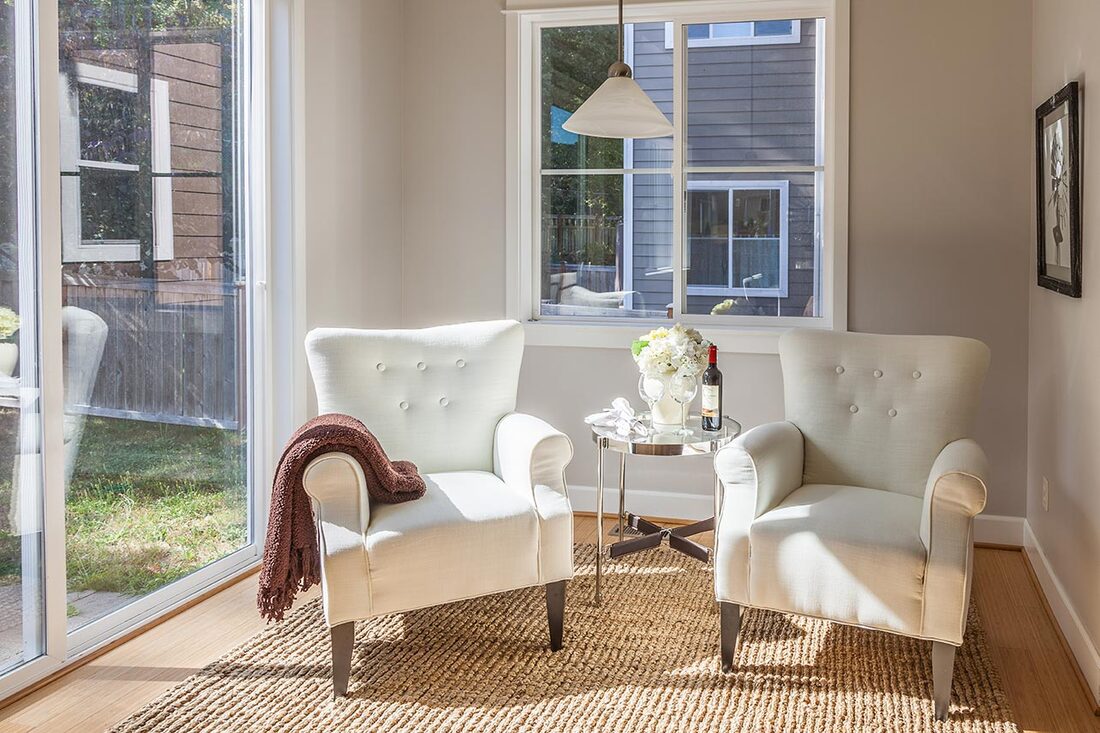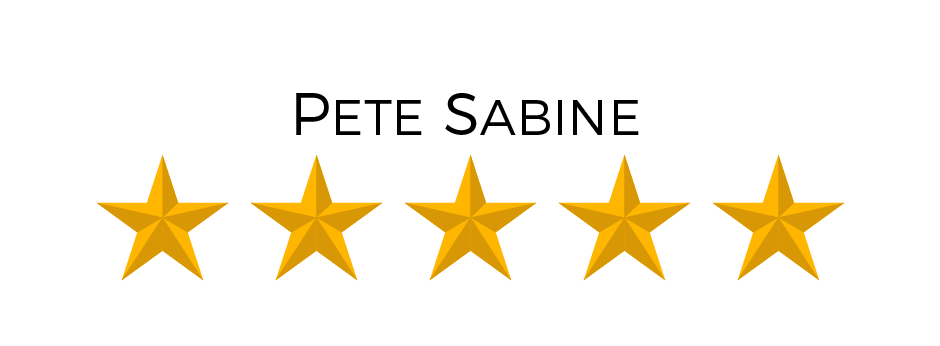Staging
Preparing your home for sale
|
Areas that might need attention both inside and outside a home.
If your home is vacant there is a lack of emotional appeal that makes it difficult for buyers to imagine living in it. Staging the house with furniture and decor will give buyers a sense of space and how it can be used. You want the buyer to feel at home when they tour your home. Staging occupied homes. The décor or remodeling can be too personalized. Take down your personal décor so that buyers can have an easier time imagining themselves living there. You might think that dark paint and fixtures in the master bathroom is incredible, but that does not mean buyers will agree. If your home improvements or decor are too personalized, most buyers will not get past your unique style and choices for fixtures and finishes. Less is more. If you have too much furniture, it will make the house feel smaller than it is. Some of the important nuances of preparing a home for in-person showings involve many factors such as ambient light, neutral colors, sounds and odors subtly effect a buyers’ impression of your home. Presentation is everything when marketing your home for sale. The primary goal of staging a home for sale.
To use design as a strategic tool to enhance a home’s best features and encourage potential buyers to see the home in its best possible light, leading to a faster sale at a higher price point and creating a strong return on our client’s most valuable investment. This allows our clients to prosper in their next endeavors and achieve future dreams and goals. Staging a home as a strategy. Our goal in home staging is to strategically ensure the most efficient, lucrative sale of your home possible by using basic design principles to focus buyers on the best features of the home. This process becomes more like merchandising and advertising a product than like decorating a home for a client. Our focus is on what buyers are looking for, and which design will inspire buyers to see a home that certain way, not necessarily what our clients’ personal tastes are. Because of this, we do not ask about our client's personal tastes but rather work toward what home buyers will respond to, so our clients' can achieve their goal of a successful sale. |
The Benefits of Staging Your Home.
Preparing your home for sale can make the difference between a quick sale at full price, and a home that sits unsold for months with several price reductions. Creating emotional appeal for a home can be as simple as painting, rearranging furniture or clearing the countertops. In some cases, it requires making repairs, completing a renovation project or professional staging. Here are the first steps involved with preparing a home for sale. You need objective and honest feedback from someone who is experienced with transforming homes for market appeal.
If you prefer to have your home designed to your own specifications, we can refer you to an interior designer or furniture rental company whose process is set up for this purpose. A home can be “over staged”.
Have you ever noticed that some interiors look too “done”? No space left to move into.... not room for another pillow, let alone a human being? We believe the best way to enhance a room is to leave a little to the imagination—space for a person to enter it, become part of it, dream of what they might do with it. The strategic empty space is just as important as the items we put in. That is what establishes the personal connection between a buyer and a home and inspires the best offers. We do not want buyers to be so preoccupied with looking at "things" that we deny them the opportunity to visualize what they might do with a space once they own it. That moment of visualization is the key to establishing an emotional connection, and that emotional connection is the key to the best possible offer. Once a buyer envisions their favorite furniture piece in the home, that home becomes “the one”. Once a home is “the one”, the seller receives the best offer. Neutral colors and style keep the focus on your home, not the staging. Use decorative objects which are "content-neutral". We do not want buyers walking into a space, looking at an art piece, while their backs are to the kitchen or a gorgeous view. Their focus should be directed toward the space itself and the architectural features of the home. Keeping buyers focused on what they are buying is our goal. Neutral colors and styles allow us to achieve this. How to help buyers understand your marketing message with staging. Spaces must be "visually digestible"--that is, instantly and easily understood, with the right colors, scale and placement of furnishings and decor, to allow the buyer to feel good when viewing the home. This is especially important when considering how a space will be photographed. Nearly all your potential buyers will preview the home online before deciding whether to visit it in person. They will look at many photos very quickly. It’s important they understand what they are seeing in photos and get a sense of what your home has offer.
|
|
There is a difference between a Realtor who stages their own listings and a Realtor that hires a professional stager.
Here is what sets us apart when staging homes for our clients…it's not just about the pretty. We understand staging is a marketing tool, not just decorating. Our job is to make our clients more money on the sale of their homes. We use basic design principles to draw buyers' attention toward the architectural features we want them to see such as views, counter tops, flooring, and fixtures, while minimizing anything we don't want them to focus on, such as awkward floorplans, dated surfaces, or small or dark spaces. Statistics tell us buyers are looking for light, bright and open homes. We help your home actualize its full potential in these areas. |
For instance, we will often use strategic furniture placement to help rooms feel more open, light reflective materials to capture light in dark rooms, and perhaps repeat the accent color in your best feature, such as a kitchen backsplash, throughout the staging decor to highlight your best asset.
Just like matching a sweater to the color of your eyes.
We carefully weigh how buyers will perceive your home as they tour it, prioritizing what we want them to see and building momentum to create an emotional connection that compels them to make their best offer.
In short, our staging keeps buyers focused on your home's best features. We want buyers to leave your home saying, "what a great house", not "what a great staging job".
Additionally, when we make recommendations about home improvements, everything goes through the proverbial "Return on Investment" filter. If we do not feel it will make you money, we will not recommend it.
Just like matching a sweater to the color of your eyes.
We carefully weigh how buyers will perceive your home as they tour it, prioritizing what we want them to see and building momentum to create an emotional connection that compels them to make their best offer.
In short, our staging keeps buyers focused on your home's best features. We want buyers to leave your home saying, "what a great house", not "what a great staging job".
Additionally, when we make recommendations about home improvements, everything goes through the proverbial "Return on Investment" filter. If we do not feel it will make you money, we will not recommend it.
|
Buyers will make a judgement call online before ever visiting a home for sale.
Buyers will decide within seconds of seeing photos of your home online whether to move forward with a showing. We keep photography in mind on all projects, staging with the goal to create a relaxing yet dramatic space that jumps off the screen. It is important to know your buyer profile. We work with our stager to understand and complement our marketing strategy. We target specific markets, strategizing and considering potential buyers, how they will relate to architectural features such as floorplan, and neighborhood trends. For instance, a 4-bedroom home in a neighborhood known for great schools may be best served when shown as family-friendly, while a 3-story townhome residence above a trendy shopping area may be best served when shown as a sophisticated live and workspace with an atmosphere for entertaining. The presentation should match the buyer profile. |
None of this works without your approval and cooperation.
We believe in what we do. But we also understand that our job is to act as a consultant, giving our clients the information needed to make the best decisions for them.
We offer a no-pressure process. We believe that a friendly, approachable attitude is the best way to help our clients reach their goals.
We work hard to structure our process in a way that respects our clients during this often personal and stressful process.
The benefits of hiring a stager with their own inventory and support staff.
The stager has a warehouse full of furniture they own, delivery trucks, and team of full-time employees.
This allows the stager to have maximum control over your project, including delivery times, inventory choices, and a team that works together daily. It also allows the stager to control pricing without a third-party furniture rental in most cases, keeping pricing fair and competitive.
We believe all of this equates to a better final product for our clients.
What about your liability exposure if something goes wrong, such as personal injury, property damage and theft?
We advise that our clients only hire a stager who is fully insured for liability coverage, has workman’s’ compensation insurance, and is bonded.
As the homeowner, you are responsible for losses from theft. Therefore, you must make sure you have proper insurance coverage for either an occupied or vacant home.
What is the process to have a staging plan and proposal?
All occupied homes begin with a preview staging appointment. The stager will preview your home and take photos to develop a staging plan with your Realtor.
You will receive this plan in a Recommendation Report and Proposal with the related cost within 2-3 business days after the preview visit.
Most stagers charge a consultation fee for this package, which can be credited toward your staging installation if you hire the stager to stage your home.
If your home to be staged is vacant, you may not need a recommendations list. You may only need a proposal and cost estimate for a staging installation. Usually, the consultation fee only applies when recommendations are given.
The recommendations often consist of listing items to pack and remove, and sometimes improvements such as painting, flooring, and fixtures, depending on your goals for the sale and your Realtors’ marketing strategy.
Usually, the homeowner will hire a packer or moving company and a contractor to perform these recommendations prior to the staging installation date.
It is up to you to decide which recommendations to move forward with. The purpose of the proposal is to provide you with information to enable you to make the right decisions for your goals and budget.
What does it cost to stage a home?
The cost to stage varies with the scope of the project. The size of the home, number of rooms and areas to stage, outdoor staging, all these variables will affect the cost.
For a vacant 4 bedroom home the cost averages between $1,500 to $2,500 per month, and most stagers or furniture rental companies require a 2-month minimum contract or lease agreement.
The completed staging project.
Once completed, the staging will often look different than the way you live in your home and may look different than you expect. Staging is not meant to represent real life, but rather to give buyers a blank canvas to mentally move into, with furniture simply acting as place holders to help them visualize their own furniture.
Additionally, staging items are props which are not meant to be lived on so you may consider planning for this by leaving your own linens in the house as well as other necessities.
For occupied homes, a stager will often try to use as many of your own items as possible for your convenience. Some of the best stagers will leave a flyer with helpful hints to make living with staging as convenient as possible.
We believe in what we do. But we also understand that our job is to act as a consultant, giving our clients the information needed to make the best decisions for them.
We offer a no-pressure process. We believe that a friendly, approachable attitude is the best way to help our clients reach their goals.
We work hard to structure our process in a way that respects our clients during this often personal and stressful process.
The benefits of hiring a stager with their own inventory and support staff.
The stager has a warehouse full of furniture they own, delivery trucks, and team of full-time employees.
This allows the stager to have maximum control over your project, including delivery times, inventory choices, and a team that works together daily. It also allows the stager to control pricing without a third-party furniture rental in most cases, keeping pricing fair and competitive.
We believe all of this equates to a better final product for our clients.
What about your liability exposure if something goes wrong, such as personal injury, property damage and theft?
We advise that our clients only hire a stager who is fully insured for liability coverage, has workman’s’ compensation insurance, and is bonded.
As the homeowner, you are responsible for losses from theft. Therefore, you must make sure you have proper insurance coverage for either an occupied or vacant home.
What is the process to have a staging plan and proposal?
All occupied homes begin with a preview staging appointment. The stager will preview your home and take photos to develop a staging plan with your Realtor.
You will receive this plan in a Recommendation Report and Proposal with the related cost within 2-3 business days after the preview visit.
Most stagers charge a consultation fee for this package, which can be credited toward your staging installation if you hire the stager to stage your home.
If your home to be staged is vacant, you may not need a recommendations list. You may only need a proposal and cost estimate for a staging installation. Usually, the consultation fee only applies when recommendations are given.
The recommendations often consist of listing items to pack and remove, and sometimes improvements such as painting, flooring, and fixtures, depending on your goals for the sale and your Realtors’ marketing strategy.
Usually, the homeowner will hire a packer or moving company and a contractor to perform these recommendations prior to the staging installation date.
It is up to you to decide which recommendations to move forward with. The purpose of the proposal is to provide you with information to enable you to make the right decisions for your goals and budget.
What does it cost to stage a home?
The cost to stage varies with the scope of the project. The size of the home, number of rooms and areas to stage, outdoor staging, all these variables will affect the cost.
For a vacant 4 bedroom home the cost averages between $1,500 to $2,500 per month, and most stagers or furniture rental companies require a 2-month minimum contract or lease agreement.
The completed staging project.
Once completed, the staging will often look different than the way you live in your home and may look different than you expect. Staging is not meant to represent real life, but rather to give buyers a blank canvas to mentally move into, with furniture simply acting as place holders to help them visualize their own furniture.
Additionally, staging items are props which are not meant to be lived on so you may consider planning for this by leaving your own linens in the house as well as other necessities.
For occupied homes, a stager will often try to use as many of your own items as possible for your convenience. Some of the best stagers will leave a flyer with helpful hints to make living with staging as convenient as possible.
|
What if you want to stage but have limited financial resources
Our clients can take advantage of our home improvement loan offered through our Compass Concierge Program. You can easily access funds, select vendors and services flexibly, and pay vendors directly with Concierge Capital funds instead spending your own money to update, repair or stage your home to sell for the highest possible sales price. To make this possible, Compass has partnered with Notable, an independent lender, to provide 0% interest loans to qualifying applicants. You can borrow up to $40,000. We assist you to select vendors to complete the work on your project. Concierge Capital funds enable you to pay vendors as work is completed. There is no interest charge to you for the Concierge Capital loan. Your home must qualify under Compass Concierge guidelines. |
|
Find out about our staging and home improvement rebate program.
If your home qualifies, we offer to cover some or all the costs as a reduction in our brokerage fee. A seasoned professional Realtor makes all the difference in selling your home at the highest possible price within a reasonable time.
We know how to set the stage for your success. Hire us to win with us! 925.787.2548. For more Real Estate Tips Listen to our podcast
If your home qualifies, we offer to cover some or all the costs as a reduction in our brokerage fee. A seasoned professional Realtor makes all the difference in selling your home at the highest possible price within a reasonable time.
We know how to set the stage for your success. Hire us to win with us! 925.787.2548. For more Real Estate Tips Listen to our podcast


